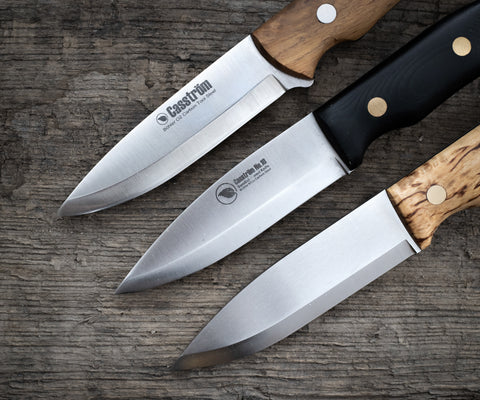
What is cryogenic treatment?
Cryogenic hardening is a treatment process where the steel is cooled to very cold temperatures with the use of nitrogen gas. This enhances the performance of the steel at a molecular level and in practical terms, gives the blade more wear resistance and is less prone to chipping compared to a blade with the same hardness that was not cryogenically quenched.
Are all Casström blades cryo-quenched?
All our fixed blade and folding models go through the cryo-quenching process.
The Järv series has not been cryo-quenched. In numerous discussions with metallurgists, it was clear that improved results on15N20 steel would be negligible.
What carbon steel do you use to make Casström bushcraft knives?
15N20 carbon tool steel is a tough and resilient steel often used in knife making and saw blades. It is well known for its excellent toughness and ability to take a very fine edge, making it ideal for working knives and tools that see impact or repeated stress. The addition of nickel not only improves strength and shock resistance but also provides the characteristic bright contrast when used in pattern-welded (Damascus) blades. Like other carbon steels, 15N20 is not stainless and requires care to prevent rust or staining.
Composition: C 0.75% Si 0.30% Mn 0.40% Cr 0.11% Ni 2.0% (~HRC 58–60)
A8 Mod a non-stainless cold work tool steel, with a medium carbon content and alloyed with chromium, molybdenum and vanadium.
It exceeds most knife steels in toughness. Toughness is a property often overlooked in knife steels, often for corrosion or wear resistance. While not stainless, A8mod steel provides decent corrosion resistance when properly maintained. Therefore, the blade should be dried after use and protected with oil or wax when stored in a high-humidity environment.
Composition: C 0,50 Si 0,90 Mn 0,50 Cr 8,5 Mo 1,20 V 0,50 (~HRC 59)
Uddeholm Sleipner steel is a tool steel well suited for knife manufacture. Once hardened, Sleipner steel offers good edge retention and is easy to sharpen, even in the field. The addition of almost 8% chromium offers better stain resistance in comparison to other carbon steels (although it should be pointed out that it is not stainless steel, and is not resistant to staining or corrosion).
Composition: C 0.9% Si 0.9% Mn 0.5% Cr 7.8% Mo 2.5% V 0.5% (~HRC 60)
What carbon steel did Casström previously use?
Böhler Tool Steel K720 (O2) is a very tough and strong oil-hardened high-carbon tool steel. The focus of the steel is toughness and edge stability. The chemical composition allows it to be hardened to a high degree whilst maintaining ductility and toughness. This means the blade holds its edge for longer at the same time as it is resistant to chipping and cracking under heavy use. This steel also has a very fine structure making it easy to sharpen and achieve a razor-sharp edge with. Whilst easy to sharpen, the low chromium content means it will tarnish if left wet and it must therefore be wiped after use and protected by oil or wax when put away for storage if you want to avoid tarnish building up.
Composition: C. 0.9%, Si. 0.25%, Mn. 2.0%, Cr. 0.35% V. 0.1% (HRC 58-60)
What stainless steel do Casström use to make Casström hunting knives?
Sandvik 14c28n is the latest development in Sandvik's range of knife steels. Optimized chemistry provides top-grade knife steel with a unique combination of excellent edge performance (stability and ability to take an edge), high hardness, and good corrosion resistance. This new grade allows for better hardness and wear resistance to previous grades without affecting the microstructure. Blade re-sharpening is therefore easy. At the same time, edge stability in terms of microchipping and edge folding or rolling is also good.
Composition: C. 0.62 Si. 0.2 Mn. 0.6 P. 0.025 S. 0.01 Cr. 14.0 N. 0.11 (~HRC 60)
What stainless steels have Casström previously used?
N690 is cobalt-enriched steel from Austrian steel company Böhler. N690 shares some properties with other cobalt-enriched steels, e.g. ATS-55 and VG-10. The cobalt increases the wear resistance of the blade thanks to the even crystal structure, allowing the blade to hold a good edge.
Composition: C. 1.08%, Si. 0.40%, Mn. 0.40%, Cr. 17.3% Mo. 1.1% V. 0.1% Co. 1.50% (HRC 58-60)
Sandvik 12C27 is a very popular stainless steel for Scandinavian knives due to the combination of good edge performance (stability and ability to take an edge), high hardness, and good corrosion resistance. Blade re-sharpening is easy and edge stability in terms of microchipping and edge folding or rolling is also good.
C 0.60%, Si 0.40%, Mn 0.40%, P(max) 0.025%, S(max) 0.01%, Cr 13.5% (average %)




